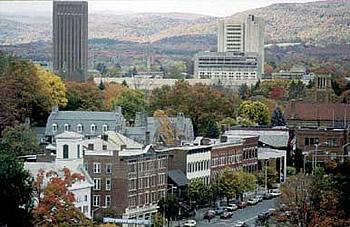Letter: Town Policies Need To Value Year-round Permanent Residents

Photo: umass.edu
When we imagine how Amherst might be an even better town than it is, we often look to other places for ideas. Sometimes it makes sense to look at what our own town once was, and imagine how we might recapture the best of what we once had.
Fifty years ago Hampshire College was up and running and had completed almost all of its hiring. Most of its employees lived right here in the town where they worked. Hampshire’s 1971-72 roster of faculty and staff numbered 183. Of those, 105 lived in Amherst. Of greater significance than the large number was the makeup of those 105 Amherst residents, because they demonstrate that even lower paid people could afford to live in Amherst.
The college’s lower paid people residing here numbered 73, 40% of all its employees — 14 janitorial/maintenance; 28 assistant professors; 31 secretarial/clerical. Higher paid people lived here, too. They numbered 32, 17% of the employees — 17 professors and associate professors; 15 deans and other senior administrators.
That means that within the memory of some who are reading this, Amherst was a place where people of all incomes could work and live. The word “workforce” wasn’t in common use, but Amherst then was the place where all of its workforce could find homes; shop for groceries and clothes in town; send their kids to school in town. And have a very short commute to work. Older readers of this article can recite the names of stores that once thrived here, responding to the demand those residents generated.
Towns are always changing. We need to plan and design the ever-changing Amherst to welcome families young anden old, our workforce, retirees….just as we accommodate the students who seek off-campus homes for the short time they are here. Planning and design follow policy. For Amherst to be the town we want it to be, our elected and appointed leadership must adopt policies that seek and welcome permanent year-round residents. Then, and this may be the hard part, they must measure all the plans and designs they review against those policies and choose only the ones that meet those objectives.
Ken Rosenthal
Ken Rosenthal lives on Sunset Avenue in Amherst. He was Chair of the Zoning Board of Appeals and of the former Development and Industrial Commission, and was a member of the Select Committee on Goals for Amherst.

I am one of the older readers whom Ken Rosenthal mentions in his letter, and I do indeed remember the Amherst of the ‘70s as a town of families and of students. I also remember it as a time of uneasiness. Mark’s Meadow School, of which I became principal in 1970, served a large population of families, many single-parent, who struggled to raise their children, complete their degrees, and put food on the table. Also in the school were the children of farming families that had lived in North Amherst for generations and were feeling squeezed out by the housing developments that inexorably replaced their farmland. The economic diversity to which Ken Rosenthal points did not make Amherst an Edenic place in the old days. Many who struggled to live in Amherst believed the town to be governed by an academic elite whose interests diverged from their own.
I fully endorse the thrust of Ken Rosenthal’s letter, but in order for Amherst to become the family town he envisions a great deal of work needs to be done, some of it uncomfortable but necessary. The divisions in town are deep, but the discussions around them are beginning to be productive, thanks to the leadership of the Bipoc community and the willingness of town government to listen and learn. I don’t want to suggest parallels among the economic, political and social divisions in town then and now, but the rise of the Amherst Taxpayers Association in the eighties and nineties reflected the resentments of many taxpayers who felt their interests were not being represented in town government. Today, the town is more responsive to residents who have felt invisible in town governance for decades, but it isn’t easy. Here, as elsewhere, the white liberals who have dominated the town are being forced to examine the town’s history and social dynamics and this requires a good deal of tough learning.
But this learning has to continue if the diversity, stability and integration that Rosenthal and i both want come increasingly into fruition. Our town boards and committees, both elected and appointed, have to find a way to function that will allow a greater diversity of residents to serve on them. Builders and developers, and the organizations that represent and serve them, need to look closely at the models of development that have been followed in recent years to see if they are as family=friendly as they need to be if Rosenthal’s vision is to come to pass.
As I write it is Father’s Day and Juneteenth and my family is having a reunion. My four daughters, who grew up in Amherst and love it as much as I do are here as are some grandchildren who don’t know the town in the same way or have the same memories or associations. Amherst is a town in which long memories and no memories must find a way of looking to the future together so that both permanent residents and transient residents can continue to call it home.